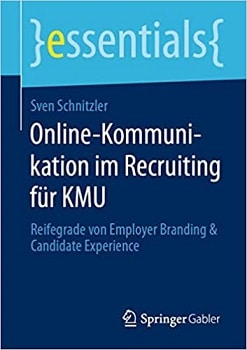Online communication in recruiting
Ralf Bruns, General Manager of the VUV Aachen and equipped with a lot of insight into the world of small and medium-sized companies, puts it as follows: “Since less and less manpower will be available due to demographic change, competition among companies will become continuously stronger. This competition will lead to a permanent pressure to optimise, also with regard to the recruiting process.”
To change the recruiting process so easily – this is especially difficult for small companies. Well-established processes, little experience with digitalisation and analogue communication channels. For these reasons it makes sense to look at a few steps before the actual action plan:
- How has communication behavior changed as a result of digitalisation?
- How has (online) recruiting changed as a result?
- How must criteria be formulated that offer SMEs both guidance and flexibility for a recruiting strategy?
From communication …
Over the years, communication has changed both through technical and social dimensions. The faster the technical progress, the stronger the change in communication behaviour. Due to decreasing communication costs and increasing communication possibilities, communication and its influence on interpersonal relationship patterns are becoming noticeably more important.
This can be seen in an increase in interactivity: Communicators play a double role in behaviour, namely parallel sending and receiving. At the same time an increasing anonymity can be observed, which is accompanied by a decreasing sense of responsibility for content, but also by an overall increasing frequency of interaction. Communication becomes more individual. Participants slip into different roles and thus try out or expand their own communication behaviour.
Our world is hypermedia in the sense of a connection between communication channels and sources of knowledge. It is almost normal for us to feel that it is up-to-date and global, where information, news, products and knowledge are available independent of time and space.
The increase in complexity through media and modern communication technologies is reflected in more complex communication processes and vice versa. At the same time, however, there is also the possibility that modern communication channels and their combination (channel blending) contribute to a reduction in the complexity of communication processes.
Almost every business process is confronted with these two opposing phenomena in the course of digitalisation. The better we balance them (and that is individual art!), the more we make use of digitalisation!
… about the employer brand …
There is a direct connection between the employer brand – perceived by the applicant as the sum of the company values and the approach in the recruiting process – and the success of the (external) recruitment of employees. The employer brand is created through a differentiated employer value proposition, a clear brand image, target group-oriented communication of the employer brand and the recruiting success as a measure. It is all the more important the more reputation is considered a highly relevant competitive factor. This results in requirements for SMEs in terms of
- visibility via the company website; in terms of recruiting, also via the career website (or a transparently designed integration into the website),
- a communication offer that is tailored to the target group (in line with their needs),
- active and applicant-centred communication,
- awareness of the impact of communication via touchpoints that are beyond the reach and control of the company,
- the orientation of the organisation towards changed social and media communication processes.
… to the online recruiting
The multidimensionality of communication must also be reflected in the recruiting process. The factor of a company’s visibility through a presence in different media is reinforced by that of credibility. Analog (one-dimensional) communication is no longer perceived as sufficient. Rather, a greater variety of communication options is associated with a higher credibility of the company. Consequently, the communication of the employer brand via various media is a prerequisite both for the visibility of a company and for trust in its employer brand.
While the knowledge of the importance of new, cross-media communication in recruiting on the employer side is certainly available, the operative implementation in practice is clearly different, especially in SMEs. Although 72% of (German) SMEs have their own Internet presence, 95% of websites have potential for optimisation. This includes, for example, optimisation for tablet and mobile phones, integration of social media and up-to-date content.
While corporations and large companies can underscore their visibility as attractive employers with appropriate campaigns, benefit from their product brand and set up the organisational structure with additional positions and budgets for this changed process, SMEs are limited here due to their size and (brand) awareness.
Criteria for a recruiting strategy must therefore be formulated in such a way that they offer SMEs both guidance and flexibility. Even if in the medium term personnel and financial investments in personnel communication and employer branding have to be made as an interface function of a company, short-term recommendations for action should be low-threshold and operable.
Maturity levels in recruiting
The causes and effects of the shortage of skilled workers in Germany are critically discussed. Here, external (political) efforts and internal measures are currently often diametrically opposed. While on the one hand, the immigration of skilled workers beyond the borders of the EU is being promoted, critics of these one-sided and, from an entrepreneurial point of view, passive efforts (“What is the federal government doing about the shortage of skilled workers?”) see the possibilities of what can be done within the organisations as not yet sufficiently used and exhausted. Rather, the problem is the SMEs in their waiting attitude – not a lack of manpower.
Against the background of the question of whether skilled workers will have to be recruited more internationally in the future, the aspect of reducing the complexity of communication processes by means of tools takes on new significance once again. Transparent online application processes with a clear Candidate Journey can also be more easily transferred to foreign applicant groups through images and visual language. Once the Employer Value Proposition is defined and known in the company, the translation of the application process and the career website is reduced to the “technical” process. The step from interpersonal to international communication is thus considerably simplified. SMEs should take this into account in their current efforts to be “mature” also with regard to cross-border recruitment.
Notes:

Sven Schnitzler
Sven Schnitzler is head of sales & strategic marketing and the Business School of the European University of Applied Sciences. He is also founder of the content & social media consultancy Doppel[t]spitze.
People follow people – according to this maxim, communication is the focus of all his marketing activities, from personnel to employer branding and corporate influencing.
